ASUS G73SW + SNB: Third Time’s the Charm?
by Jarred Walton on March 4, 2011 12:00 AM ESTSystem Temperatures
We’ll start with our usual shot from HWMonitor. I should note that I’ve received a couple emails over the past few months questioning the stability of the G73 notebooks—there are some reports floating around the net stating that the series has overheating problems. While I’m sure individual notebooks have had problems, I’ve done my best to stress the G73SW as hard as I can, including running Furmark overnight, and a second overnight run of Furmark with the Cinebench SMP rendering looping in the background. There are no stability problems to report and the HWMonitor result below shows the internal temperature ranges for the various components.
The CPU cores and GPU all report a maximum internal temperature of 75C. That’s the same GPU temperature we recorded on the MSI GT680R, but the G73 is 8C cooler on the CPU temperature. So as far as temperatures go, I’m not at all concerned with the ability of the G73 chassis to deliver the goods. That doesn’t mean quality assurance (QA) is always perfect, or that there won’t be the occasional lemon in the batch, but stability, heat, noise, and performance were never an issue with this particular test sample. Ironically, we can’t say the same for the LCD (see below), but given the prerelease nature of our test unit (it was one of the CES 2011 show models, apparently), we’ll let that slide.
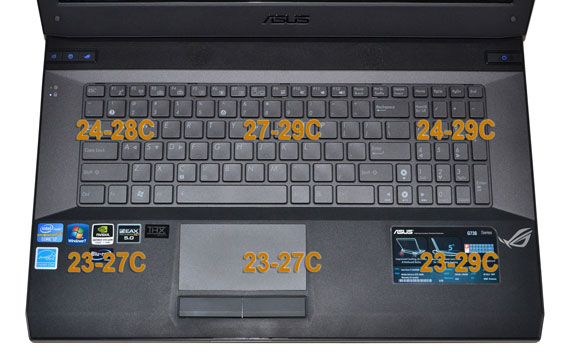
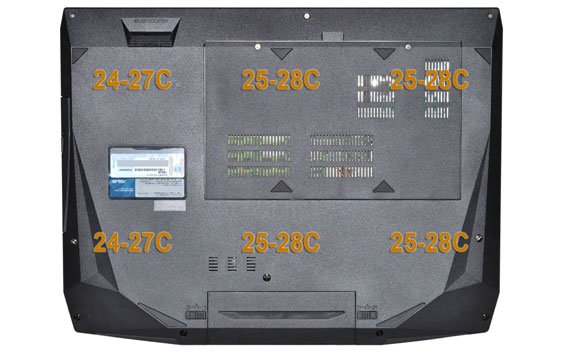
While the internal temperatures hit 75C, the surface temperatures on the G73SW are a lot lower. Unfortunately, my digital thermometer broke in the course of testing [that or the laptop was suddenly 95C or hotter on the surface], so I can’t provide load specifics. The above images show the idle surface temperatures; I’d estimate that the hot spots are around 5-10C higher under load, and in general the notebook runs reasonably cool considering the components. As stated in the intro, the large chassis does an excellent job at removing heat, and it does so without getting particularly loud. Idle noise levels measured 31.0dB at 18” and load noise (with Furmark and Cinebench SMP) topped out at 37.6dB. The noise also tends to be lower in pitch, so the G73 is very quiet compared to other gaming notebooks.
My guess is that the only thing between the G73 chassis and a GTX 485M or HD 6870M is the power brick and power circuitry, because the cooling setup looks like it still has plenty of headroom—especially if ASUS were to ramp up fan speeds and noise levels to compensate for the additional heat. The other thing keeping such high-end GPUs out of the G73 line is most likely price; ASUS has stated in the past that as soon as they start pushing beyond $1000, sales figures start to drop, and at $2000+ they plummet. That makes sense, though I’d still love to see some more competition for the high-end Clevo notebooks that can easily run into the $2500+ range.
What About the LCD?
As I mentioned above, there was an issue with our particular unit’s LCD. It’s not something that would affect benchmarks (outside of our LCD tests), but it was certainly distracting. At the heart of the problem are two things: first, the LCD would periodically flicker black. The only other time I’ve seen something like this was with a pre-release Dell Studio XPS 16. [Update: Several readers pointed out that this is an NVIDIA 266.58 driver bug specific to the G73SW.] The second problem with the panel is that there was a huge bright spot in the lower right that would show up once the panel got warm. You can see this as a yellow discoloration in the image below.
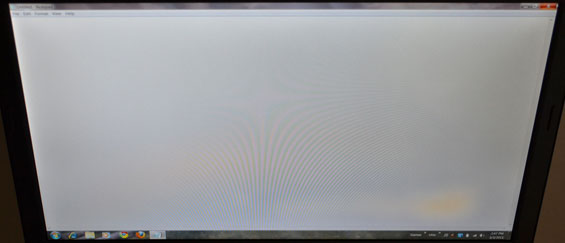
It appears to be a manufacturing glitch with the various layers of the LCD. If I purchased a notebook with this problem, you can bet I’d send it back. ASUS offered to ship me a replacement, but this problem isn’t something I’m overly concerned with. We’ve tested this same HannStar 171PUW-1 panel several times already, and the characteristics are always about the same. It’s got a great contrast ratio, a reasonable color gamut (particularly if all you’re concerned with is the sRGB color space), and it’s a nice 1080p display. That said, something really needs to be done about the relatively low maximum backlight intensity; it would be great to see 400-nit maximum white levels, with the ability to drop down to 50-75 nits minimum for dark LAN parties. Indoors, 155 nits is fine, but if the LCD is exposed to bright lights (i.e outdoors or in a harshly lit environment) you’ll have serious reflections. Actually, what would be ideal is to get matte LCDs with at least 750:1 contrast, but those seem to be a rare breed outside of MacBook Pros. Anyway, here are the LCD performance charts, with results slightly worse than the G73JW we tested previously.
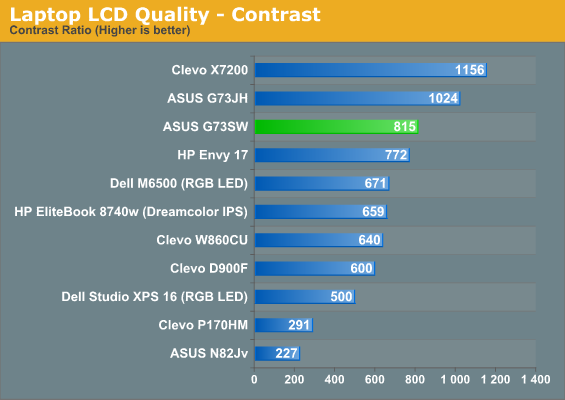

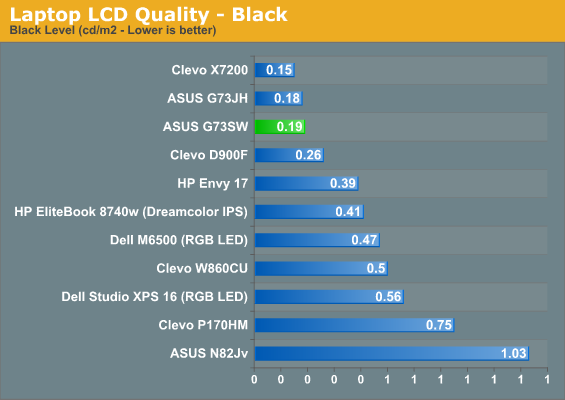
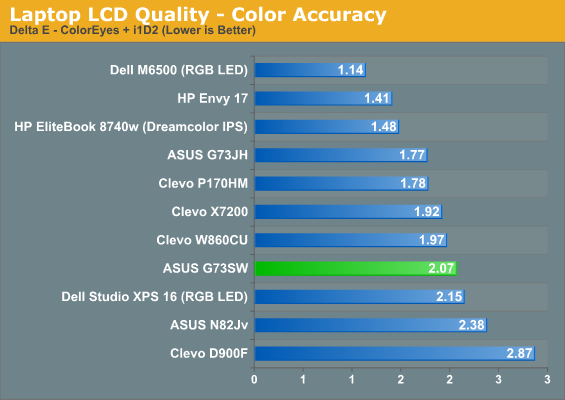
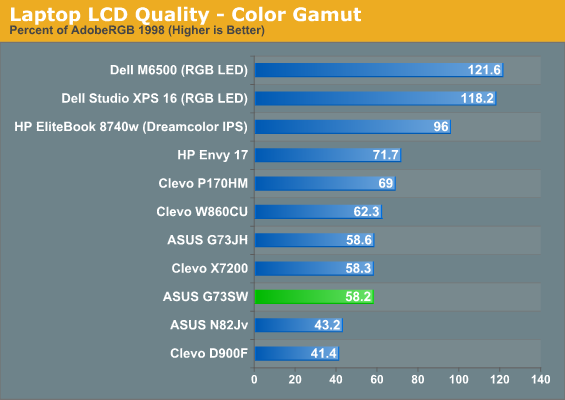
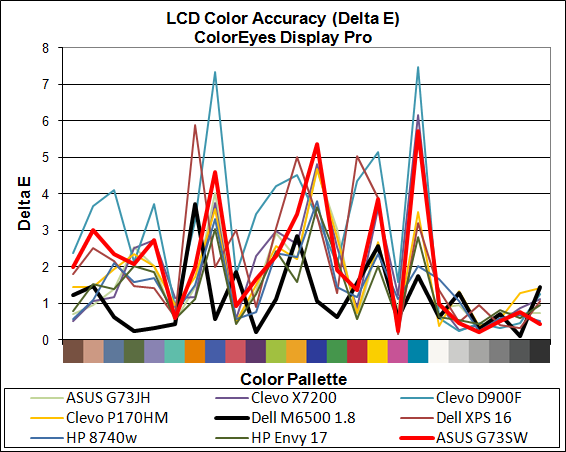
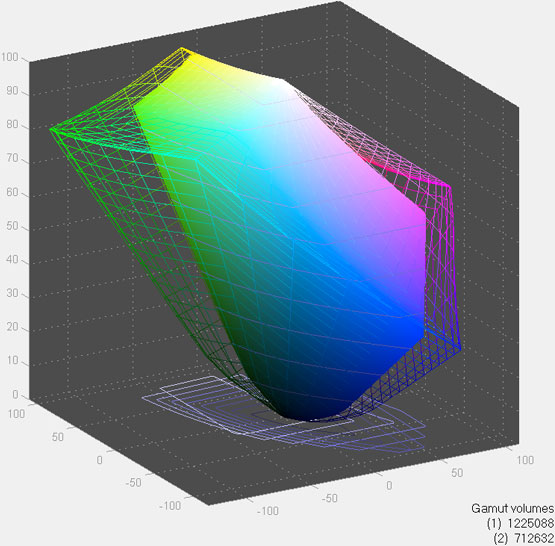


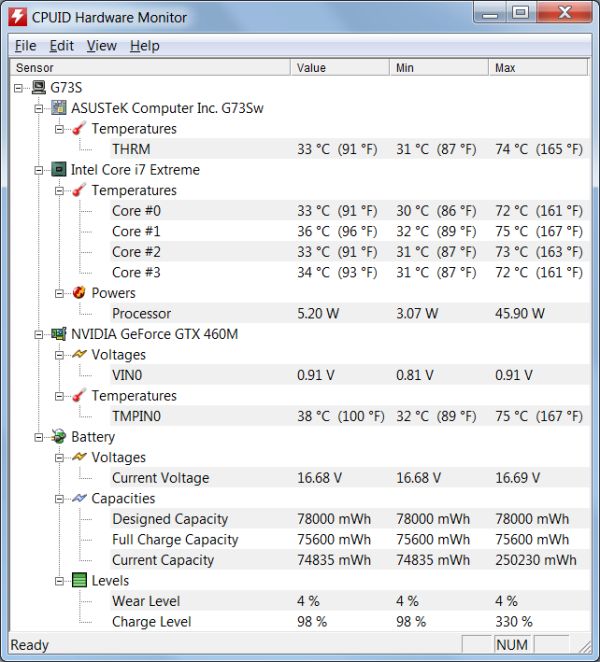














56 Comments
View All Comments
Frallan - Friday, March 4, 2011 - link
I bought an old ASUS gaming lappy with turbo and the 6800GT in it it has served for a long time now and has been demoted to girlfriend computer now. So Im in the market for a new gaming lappy. BUT when spending that much money I want to have decent performance.Therefore I will wait until there is a good sandy brige / GPU combo is out there. Id like it to come from ASUS bc of the good experience Ive had with the old Lappy but if this is what they will have then they\re out of the game.
BR
/F
jcandle - Friday, March 4, 2011 - link
"Contenders like the MSI GT680R (going for $1475 online) offer nearly identical specs"Hey Jarred, how is that a contender? The MSI is a 15 and the Asus is a 17. I have no idea why but bigger in gaming notebooks generally translates to more expensive. Perhaps manufacturers are betting gamers place value on tonnage.
JarredWalton - Friday, March 4, 2011 - link
It's a gaming notebook, therefore it's a contender. The ASUS G53SW is also in the rink, along with Clevo P150HM and P170HM. I'm also a bit surprised that there are essentially equivalent spec notebooks that are smaller and cost less; that's usually not the case. Perhaps the high contrast HannStar LCD is adding more to the total than I think?jcandle - Friday, March 4, 2011 - link
That's exactly my point. Its not an apples to apples comparison because Asus does have the G53SW that essentially the same machine with 1 less HDD with a much lower price point resolving the pricing issue you were so lamenting. You can't compare a 17" machine and says its more expensive than a 15" when similar offering from companies like Dell with Alienware are doing exactly the same thing.JarredWalton - Friday, March 4, 2011 - link
The MSI still supports two HDDs, though, which means the only difference is the overall design elements and the LCD size. The LCD should be a wash, really (both are 1080p, so maybe $25-$50 difference at most). ASUS has the keyboard backlighting and better thermals. Do those three items add up to a nearly $300 price difference? I don't think so.If you go with the ASUS G53SW-XR1 and compare that to the MSI, you still have to factor in the single HDD. I'm also a bit concerned that ASUS might be selling some B2 stepping chipsets with a single HDD, but I don't know for sure if that's the case. Will the Cougar Point bug affect the DVDR or eSATA down the line, or if you add a second HDD/SSD will that be a problem? Hopefully I'm wrong and they're not selling any B2 chipsets in the G53/73 chassis.
Anyway, I've edited the text slightly to clarify that I'm looking at all similar performance gaming notebooks, not necessarily just "all 17.3-inch heavyweight contenders". :-)
jcandle - Friday, March 4, 2011 - link
Don't get me wrong I'm backing you up on the point that "essentially equivalent spec notebooks that are smaller and cost less" Maybe there should be some investigating to find out why manufacturers are simply bumping up the form factor and asking for a non-proportional $300 price difference.mattwco - Saturday, March 5, 2011 - link
When stock levels come back, there's an -XR1 variant that has one HDD and a DVD-RW for $1400. It may have a lesser warranty as well.If you're comparing the G73SW to other laptops, please note that there's more than one G73SW. BTW, the 3D version is also coming back in stock at ~$1900.
mattwco - Saturday, March 5, 2011 - link
Jarred mentioned the XR1 version above. Several other variants are available at different price points. The -B3 has a better warranty than the -A1.Example, not company recommendation:
http://pro-star.com/index.cfm?mainpage=product&...
Also, the laptops with the fixed chipset are explicitly labeled so on the laptop and on the box.
http://www.asus.com/News.aspx?N_ID=Bdmf9rXuqU29SRs...
piroroadkill - Friday, March 4, 2011 - link
8GB is thoroughly pointless, as is a quad core.I'd much rather have a higher clocked dual core for gaming... 4GB RAM is just fine..
... and mechanical disks? One SSD, one Mechanical disk is the correct way.
piroroadkill - Friday, March 4, 2011 - link
I should note, on my dual/quad comment, I meant that a higher clocked dual core would be a better tradeoff for performance/power use in the vast majority of games. Obviously a high clocked quad is the best of all worlds.